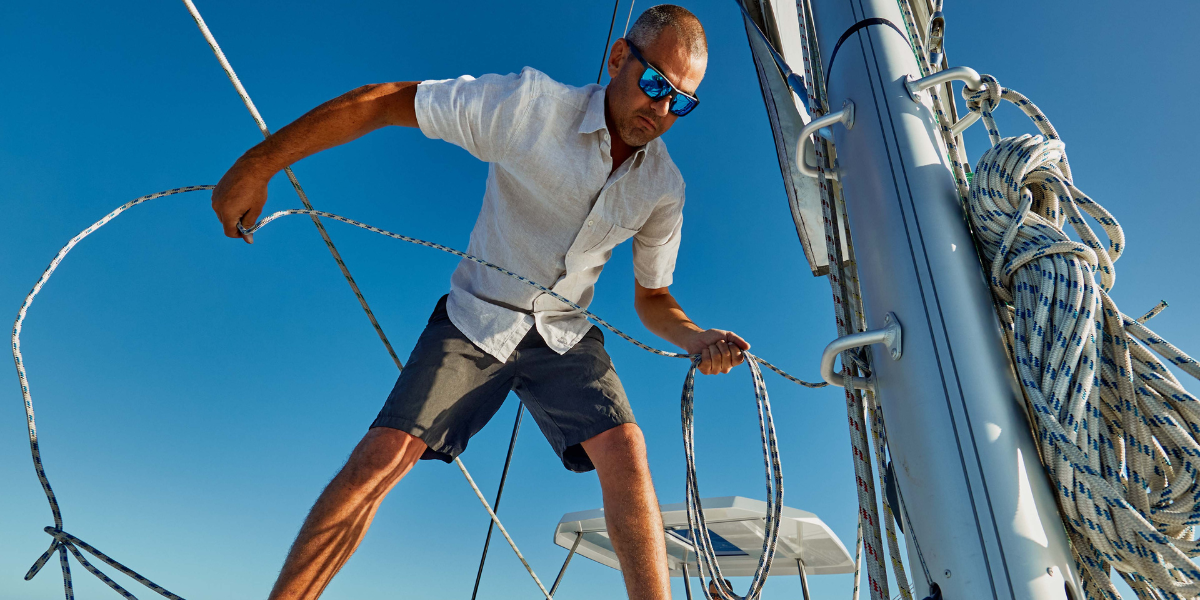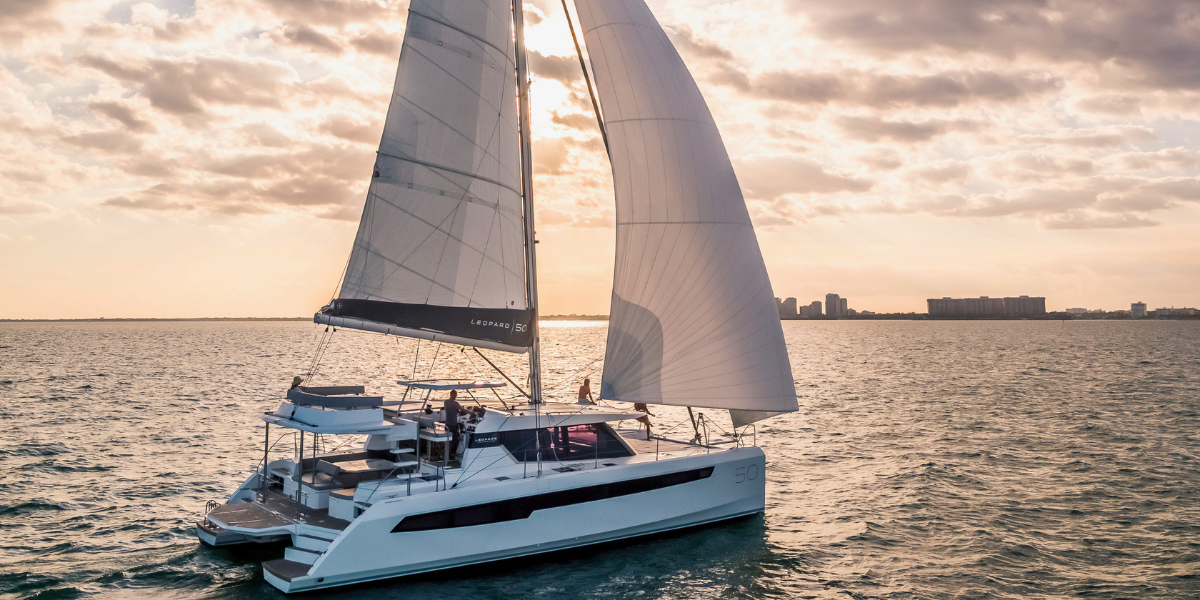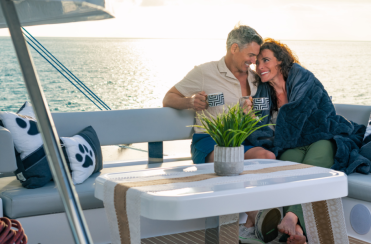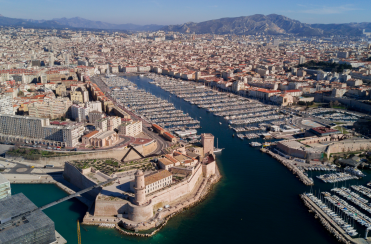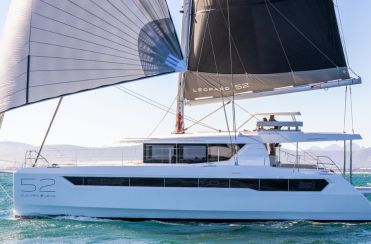Sails are among the largest and most important purchases you’ll make for your Leopard. Whether your boat is in a charter fleet in the Caribbean, on a nearby slip for weekends, or your full-time home as you cruise the world, when it comes time to your sail inventory, you want the best choices for your budget and how you use the boat.
To help inform those decisions, we spent some time chatting with Leopard designer Alex Simonis of Simonis Voogd yacht design. Simonis Voogd has been involved with Leopard for over twenty-five years and designed most of its models, including the more recent Leopard 42, 43, 45, 48, 50, and 58. We caught up with him between meetings at a sail loft in Cape Town.
Power and Sail Handling
“The trend over the years has been to make (catamarans) bigger and more comfortable in terms of amenities,” said Alex. “So it’s a balancing act to keep these boats going well and keep it manageable at the same time.”
As a designer, he wants a full-powered sailing rig, but not a sail plan that’s so unwieldy that a small or inexperienced crew can’t manage it. To keep a heavier boat sailing well, you need a big mast, but the rig can only be so tall. You must be able to set, douse, reef and trim when the wind picks up.
The mainsail is large and gives a lot of driving power by design, but it’s the easiest sail to handle since it attaches at the luff and foot. Lazy jacks or stack packs will keep a large sail tamed, but you will still get a lot of drive from this sail. They built the Leopard sail plan around this driving force.

Overlapping headsails
Though some catamaran designers opt for small, self-tacking jibs for ease of handling, they design Leopards for larger, overlapping headsails.
“We always use overlapping Genoas because, with a non-overlapping jib, you lose your slot effect between the mainsail and the headsail,” Alex adds. “And there’s a 15% to 20% efficiency increase in that slot you can create with an overlapping headsail.”
Instead of sheeting a small jib into tight sheeting angles, you’ll get better performance in lighter air with a larger headsail and a less aggressive sheeting angle. As the boat speeds up, you’ll build apparent wind and progress more upwind even though you’re not pointing as high.
The Leopard diamond rig also limits sheeting angles but isn’t a problem, according to Simonis. Cruising catamarans with shallow keels sail differently from monohulls or cats with daggerboards.
Alex advises that you “don’t pinch as high into the wind as you can. It doesn’t pay. Just bear off and get your speed. Your shallow keels really start working well between seven and eight knots.”

Light air and downwind
Your choice of downwind and light air sails depends on how you sail and your skill level. Most boats in charter don’t keep downwind sails in the charter inventory, but cruisers and performance sailors may have an array of choices to keep the boat moving well off the wind.
“The cruising sailor on the Catamaran has evolved,” Alex said. “They are getting more performance orientated, and that’s a healthy development because you can sail very nicely with a cruising cat. But it’s like anything else. If you want more speed, you have to work a bit harder.”
The most popular sails for off the wind and light air are code zero and D sails and asymmetrical spinnakers. Both code sails and spinnakers are “free-flying” sails attached only at the head, tack and clew. Code sails are flat cut from heavier cloth, and spinnakers are light and full like parachutes.
A flat Code zero or a huge Code D will both furl and are easy to set and store and give your Leopard enough drive to keep covering miles on light air reaches up to 60 or 70 degrees apparent. A Code D is easier to handle than a spinnaker in big downwind breezes, but in light, to medium downwind conditions, you’ll be fastest with a spinnaker.

Materials and construction
Choice of cloth and construction technique is the big driver in sail costs. From less expensive Dacron sails to laminate sails with high modulus fibers, you trade weight, durability, shape, and costs to get the right sail for you.
“Sail selection is very budget-driven,” Alex said. “Even if it’s all computer designed, your relationship with your sail maker is quite personal, and your choice of sails is like choosing your clothes. How far do you want to go, and how much do you want to spend?”
Alex prefers laminate sails because they’re lighter and easier to handle, and they keep their shape well. The tradeoff is price and durability. But for long-distance cruisers, Aramid blends (like Spectra) and woven cloth may be a better choice. If you change sails frequently, your life will be easier with a light, laminate sail.
“If you say, ‘I like a good turn of speed, and I want a nice setting sail when the breeze is up,’ then it pays to go for a more stable cloth, be it Spectra or a laminated sail. Spectra sails are far more stable than Dacron sails.” Alex adds, “This is a big thing because a big mainsail on the cat gets loaded up if the breeze goes up. And if the sail cloth isn’t stable, the Dacron starts stretching at the leech, and it starts falling off to the leeward side. Then it’s not a sail anymore. It’s just a flap of cloth hanging in the wind. It doesn’t drive the boat.”
If you’re new to sailing and Leopard Catamarans, the basic sail package offered with your boat is a solid option to get you going. But if you want some more performance, or you’re planning to do serious offshore sailing, talk to a sailmaker or consider an upgraded sail package from the start.
Your Inventory
During our conversation, we got Alex to open up about what he’d do if he were equipping a new Leopard for himself.
“If I fantasize for a second about what I’d do on my boat,” he says, “I would have a laminated, lightweight main to maximize the stability of the cloth versus the weight of the sail because that will give me the best possible driving power and handling. I’d rather have a sail that lasts just three or four years but always sets beautifully and is always easy to get down by myself than a sail that is an absolute bear to handle, and the moment the wind goes over 20 knots, starts to look like it just came out of a washing machine.
“I would use the code D in the really breezy downwind stuff because it’s easier to handle. And in the light and medium stuff downwind, I would use a big asymmetric spinnaker. Then you have a seriously nice sail wardrobe, which can take you from two to 40 knots in all wind directions. And that’s five sails: main, jib, code zero, code D, and asymmetrical.”
The designer’s choices for his boat won’t be the same as yours, but they’re a place to start. When you think about sails and talk to a sailmaker, consider how and where you’ll sail, who will be with you, and your budget for new and replacement sails over the life of your boat.
